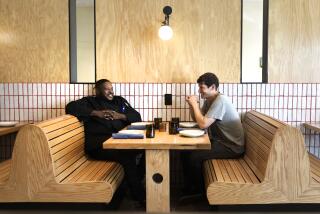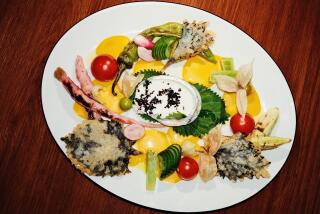Changing the blend at Copia
- Share via
COPIA is reinventing itself. Again. Now that grandiose plans to elevate the Napa center for food, wine and the arts into the top ranks of American cultural institutions have collapsed, its president is refocusing Copia on one simple idea: wine.
A vision to supplant the older, more established New York-based James Beard Foundation as the standard-bearer for America’s food culture has been abandoned. Starry-eyed dreams of creating an Academy Award-style food and wine awards program have been shelved.
Instead, Copia President Arthur Jacobus wants Copia: the American Center for Wine, Food and the Arts to become a mecca for wine enthusiasts. Although wine was always part of Copia’s programs, it was easily overlooked by the public and often taken for granted within an institution struggling with its focus split among art, food and wine. Novice wine lovers will still find plenty of casual wine tastings at Copia. But the offerings are being expanded to appeal to more sophisticated wine drinkers as well.
“Here we are in Napa; Robert Mondavi is our founder. It’s all about the wine,” Jacobus says. “We decided we would aspire to be the preeminent wine education and discovery center.”
Wine-geek nirvana is more like it. This summer, Copia unveils its new identity in the institution’s gardens as vegetables give way to vineyards. Displays of soils will illustrate the role that rocks, sand and clay play in wine.
Ever wonder about different trellis systems? You’ll be able to study them at Copia. Dry farming versus drip irrigation? There will be a display.
Inside Copia, Julia’s Kitchen, a restaurant named after celebrated cookbook author and television personality Julia Child, will still strive for culinary excellence. But rather than the food being an end in itself, the focus will be on food and wine pairings, highlighting the role of wine at the table.
Most significantly, wine will dominate Copia’s exhibits. Automatic wine dispensers will allow visitors to taste the difference between American oak barrel aging and French oak barrel aging. No esoteric question that nags wine cognoscenti will be ignored.
“Copia will be the first stop for visitors to Napa Valley,” says Peter Marks, Copia’s wine director. “We want to help them understand why wines taste the way they do.”
Marks also wants to plant Copia’s flag as the center of formal wine education in America. The United Kingdom-based Wine & Spirit Education Trust courses available at Copia will be expanded. Copia will offer three times as many courses this year as last year. And not only in Napa. Copia will open a satellite location in San Francisco for wine classes. Many of the courses will be offered online.
“There is a hunger for these courses. Wine education is critically important to the industry,” Marks says. “It will build.”
In its exhibition hall, Copia is building a new showcase for the winners of its wine awards. Relying on a network of wine professionals who have achieved the status of Master Sommelier or Master of Wine, three nominees are selected for outstanding vintner, grower and collector. Robert M. Parker Jr., Hugh Johnson and Jancis Robinson determine the final awards.
One aspect of Copia’s former grandiose plan not only survived but expanded. Copia is striving to turn itself into the hub of a wine destination resort with at least three projects. On land next to Copia, a Ritz-Carlton hotel under construction is scheduled to open in late 2009. This summer, on land leased from Copia, the Oxbow Public Market, a retail and food complex modeled after San Francisco’s Ferry Building Marketplace, is scheduled to open with outposts of Napa eateries including Taylor’s Refresher and Model Bakery.
On property across the Napa River that Copia sold to developer Intrawest, a Westin condominium-hotel is under construction and is expected to open mid-2008. And, recently, Copia put up for sale 4 acres next to its parking lot hoping to find a buyer to create another development.
“We’re trying to create a village built around wine and food,” Jacobus says. Several miles of bike and walking paths along the river are part of the plan. “These are bold strokes for developing the whole region so that it is larger than just Copia.”
Founded five years ago with a $20-million gift from Mondavi, Copia floated a $70-million public bond to build its 80,000-square-foot facility with 3 1/2 acres of gardens. The expectation was that, planted in Napa, Copia’s focus on food, wine and arts would be far greater than the sum of its parts.
Napa’s glitterati flocked to Copia. Vintners Garen Staglin and Ann Colgin joined the board of trustees along with wealthy newcomers such as Darioush Khaledi and Frank Husic. The list of honorary trustees is a who’s who of wine and food, including Jacques Pepin, Jancis Robinson, Martha Stewart, Alice Waters and Jacob Rothschild.
The alchemy never happened, however. Scattershot programming produced no must-see attractions. A $12.50 admission fee scared off tourists and locals alike. With insufficient income to pay for the 80-person staff along with an annual $5-million debt payment, the financial picture was grim.
When Jacobus arrived to be Copia’s new president in July 2005, the former president of the Kentucky Center for the Performing Arts in Louisville and, for 10 years prior, the executive director of the San Francisco Ballet declared fundraising to be his immediate priority. That wasn’t the consensus of Copia’s board, however.
Several members believed there was money to be made in taking advantage of another institution’s misery: The James Beard Foundation appeared to be in a death spiral. It was an opportunity for Copia to expand its reach.
In 2004, an accounting scandal ripped apart the James Beard Foundation. The American food society’s president Leonard Pickell Jr. later was indicted and subsequently pleaded guilty to second-degree grand larceny after an internal investigation revealed $1 million in questionable expenses. Six months later it remained debatable whether the foundation could reorganize successfully.
Jacobus went to see the new chairman of the foundation’s board, Dorothy Cann Hamilton, founder and chief executive of the French Culinary Institute in New York City. Looking across a dining table in the culinary institute’s restaurant, Hamilton bluntly asked him, “What is Copia? What’s your bull’s-eye?” Jacobus couldn’t answer.
Despite the Beard Foundation’s struggles, Hamilton was certain about its mission. “The heart of our mission is preserving and supporting our American culinary heritage,” she says. “It’s the celebration of chefs and restaurateurs in our country. Everything else moves in ever larger concentric circles beyond that.”
Jacobus had been chasing the idea of a Copia celebrity awards program, taking trips to Las Vegas in search of a casino partner for a televised show. Not until spring 2006, after the casinos had turned down Jacobus, and advertisers turned tail at the idea of underwriting such a venture, was Jacobus ready to address Hamilton’s question.
Last year, Copia hosted a 30-year anniversary repeat of the 1976 Paris wine competition that rocked the wine world when California’s wines were judged by French wine experts to be superior to their French counterparts. It was big news in the wine world when California’s wines again outscored the French.
“It was the ‘duh’ moment,” Jacobus says. While he re-imagined Copia as, first and foremost, a center for wine studies, he slashed Copia’s 80-person staff to 53 people. Anything that doesn’t involve wine is gone, he says.
*
More to Read
Eat your way across L.A.
Get our weekly Tasting Notes newsletter for reviews, news and more.
You may occasionally receive promotional content from the Los Angeles Times.










